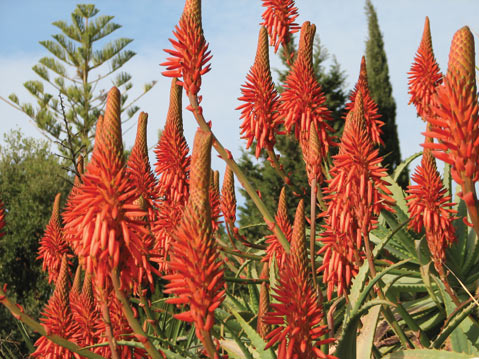Aloe Time
Showy Flowers Rise Out of Spiky Surroundings

Aloes are hard to miss in the area landscape because they are everywhere. When they are blooming, as they are starting to do this month, they are particularly evident. Showy flowers in shades of orange, coral, and sometimes yellow, rise out of their spiky surroundings, attracting the attention of hungry hummingbirds, as well as us humans.
Native to the dry habitats in Africa, aloes come in a staggering variety of shapes and sizes. The smallest rosettes hug the ground just a few inches tall and across, while their arborescent (that just means “treelike”) cousins can reach heights of 30 feet or so. Whatever their size, almost all aloes are armed with some spines. For the most part, these teeth occur just along the edges of the leaves and are no great threat to bodily harm. They are generally brittle and break off leaving only minor scratches to the gardener in charge. One of the most likable species, Aloe plicatilis, has such small teeth on the edges of its flat, gray leaves that they are almost un-noticeable. This plant looks like a sculpture composed of tongue depressors. Other common ones include A. arborescens and a hybrid of A. ferox and A. wickensii often called Aloe salm-dyckiana. These two branch prolifically, eventually forming dense clumps up to five feet or more in height and are planted all around Santa Barbara and its environs. If it looks like a blooming aloe this month, it is probably one of these latter species.
All aloes naturally grow in warm to hot climates and in soils that tend toward the dry side. Most are fairly forgiving of the area’s heavy soils, but for all aloes, it is wise to site them on sloping or raised beds and incorporate sand into the soil for best health. While they can withstand long periods without water, aloes will bloom and look their best with infrequent, but regular, irrigation.
Besides their inherent good looks, aloes are noted for a number of other beneficial attributes. Almost all of them contain some amount of the compound called aloin, which gives them medicinal value. Aloe extracts have been used as a purgative to treat stomach complaints, but the most common use for the juice is to treat burns and other skin irritations. Commercial sources of the most active aloe ingredients, aloin, are mainly produced from one species, Aloe barbadensis, commonly known as aloe vera. Many cosmetic products, from skin creams to hair-care products, now contain aloe gel, the homogenized fleshy inner portion of the leaf. Without investing in these processed products, it is a simple matter to break off a leaf and apply the gel of aloe vera or one of its close relatives such as A. ferox and apply it directly to the skin for instant first-aid treatment of burns or minor wounds.
More and more different species of aloes are being propagated and are increasingly available. Check out Terra del Sol in Goleta for one of the largest area selections. For lots of excellent advice on not only names of aloes and their hybrids but also growing information, go to wholesale nursery San Marcos Growers’s website. If the aloe is listed there, it will be available at a local nursery — perhaps not every week, but certainly by special order.



